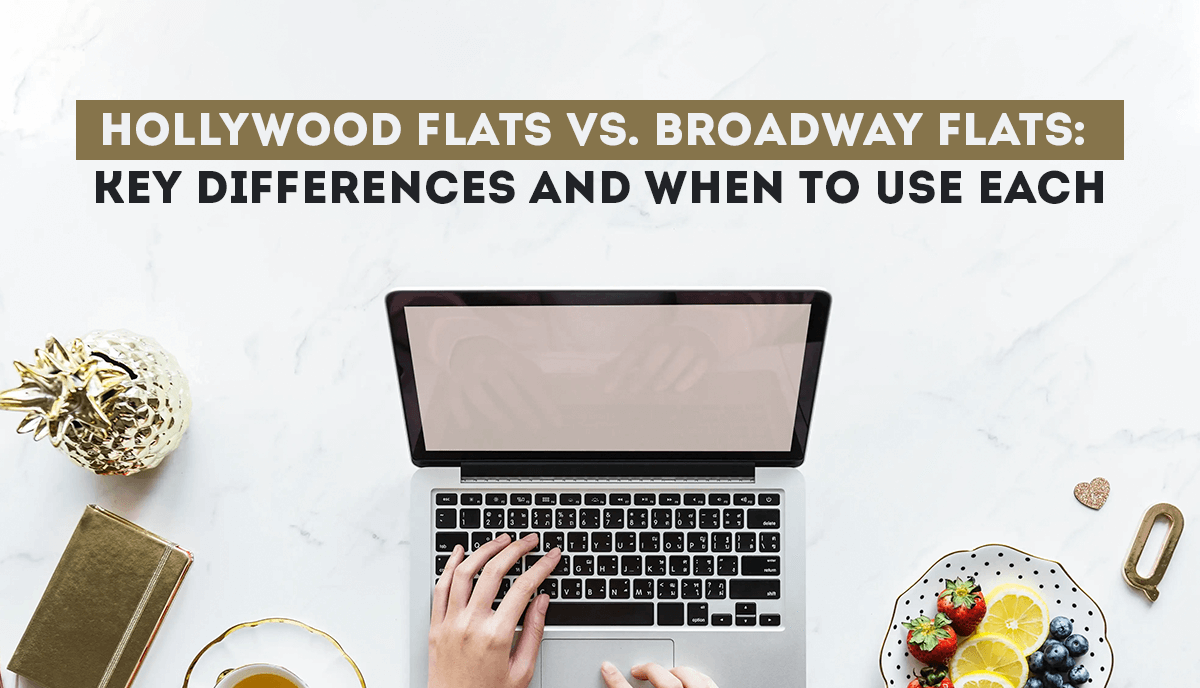In set design, choosing the right flats can transform a stage or film set into a captivating world. Whether you’re designing a theatre production or working on a movie, selecting between Hollywood flats and Broadway flats is crucial to the success of your scenic design.
Both types of flats offer unique advantages, and understanding their differences will help you decide which is best suited for your project.
This blog post covers the key differences between these two types of flats and when to use each for optimal results.
What Are Hollywood Flats?
Hollywood flats, also known as hard flats or rigid flats, are commonly used in film set construction due to their solid, durable build. They are framed with thick lumber, typically 1×3 or 1×4, and covered with a hard surface such as plywood or lauan.
What Are Broadway Flats?
Broadway flats, also known as soft flats, are the preferred choice for theatrical productions. These flats are framed with thinner wood, usually 1×2, and covered with muslin or canvas, which is then painted to create the desired backdrop.
Materials and Construction Differences
The materials used in Hollywood flats vs. Broadway flats differ significantly. Hollywood flats are made with a more robust wooden frame and a hard surface, making them durable but heavy. In contrast, Broadway flats use a lighter frame with a soft covering, often muslin, which is then painted to achieve the scenic effect.
The flat construction methods also differ. Hollywood flats are designed for strength and stability, making them ideal for productions where the set must support interaction with actors. Broadway flats, on the other hand, are intended to be visually appealing rather than physically sturdy, making them a better fit for background scenery in theatrical set construction.
Assembly and Durability: Which One is Stronger?
When it comes to durability, Hollywood flats are far superior. Their rigid frame and hard surface make them capable of handling rough treatment and repeated use. Hollywood flats assembly is straightforward, typically involving screws or bolts that ensure a sturdy build.
Broadway flats, while easy to assemble, are not designed for heavy-duty use. Their lighter frame and fabric surface mean they’re more suitable for productions where the set is mainly for visual purposes, like painted backdrops. However, their flexibility and portability make them the go-to choice for productions that prioritize fast assembly and easy movement.
Portability and Storage Considerations
For productions requiring portable flats, Broadway flats are the best choice. Their lightweight, foldable design makes them easy to store and transport, which is crucial for traveling shows or venues with limited storage space. Broadway flats can be stacked and stored flat, taking up minimal room when not in use.
Hollywood flats, on the other hand, are bulkier due to their solid construction. While they provide more durability, they require more space for storage and are harder to transport. Productions that don’t need to move their set frequently may opt for Hollywood flats, but for those with mobility needs, Broadway flats are far more practical.
Weight and Transport: Which is Easier to Move?
Weight plays a significant role in the decision between Hollywood and Broadway flats. Hollywood flats are heavier, making them more difficult to transport and move around a set. However, their weight also adds stability, which is a key factor in productions where the set needs to remain stationary or withstand physical interaction.
In contrast, Broadway flats are much lighter and easier to move. Their lightweight frame and fabric covering make them ideal for movable flats, especially in theater productions where frequent set changes are required. If ease of transport is a priority, Broadway flats are the better option.
Usage in Different Productions: Film vs. Theater
The type of production heavily influences the choice between Hollywood flats and Broadway flats. Hollywood flats are perfect for film set design, where realism, durability, and the ability to interact with the set are critical. Their hard surface allows for intricate detailing, making them ideal for close-up shots and interactive scenes.
For theater set design, Broadway flats are the preferred option. Their lightweight construction and portability make them easy to move, and their flexible design allows for quick scene changes. Broadway flats excel in theatrical productions, where sets need to be quickly adjusted between acts.
Cost and Budget Considerations
The cost of Hollywood flats tends to be higher than Broadway flats due to the more expensive materials and labor required for construction. Hollywood flats are an investment, particularly for film productions that require durable, reusable sets.
On the other hand, Broadway flats are typically more budget-friendly. Their simpler construction and lightweight materials make them a cost-effective option for theater set design or smaller productions with limited budgets. If your production requires budget-friendly flats that can still achieve a stunning visual effect, Broadway flats offer a more affordable solution.
When to Use Hollywood Flats
Hollywood flats should be used in productions that require durable, realistic scenery. If your set needs to withstand physical interaction or detailed set dressing, Hollywood flats are ideal. They are best suited for film sets, where the camera captures intricate details, and the set needs to hold up under scrutiny. Professional set designers working in film or TV often choose Hollywood flats for their reliability and strength.
When to Use Broadway Flats
Broadway flats are perfect for theatrical productions where speed, portability, and flexibility are key. Their lightweight design makes them easy to move and adjust, especially in productions with fast-paced scene changes. Broadway flats excel in stage flats for theater, providing a beautiful visual backdrop without the need for heavy-duty durability.
Choosing the Right Flats for Your Production
When deciding between Hollywood or Broadway flats, consider the needs of your production. For film set design, where strength, realism, and durability are essential, Hollywood flats are the best choice. For theater set design, where portability, flexibility, and ease of assembly are important, Broadway flats are the way to go.
Conclusion
The choice between Hollywood flats and Broadway flats depends on your production’s needs. Hollywood flats excel in creating sturdy, realistic sets for film and TV, while Broadway flats shine in theater with their lightweight, flexible design.
If your priority is durability and interaction, go with Hollywood flats. For portability and quick scene changes, Broadway flats are your best bet. Choose wisely to enhance your set design.

